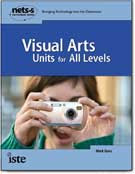Nice article from EdTech Focus on k-12...
"Technology Can Make Art History Lessons Come to Life
New and emerging tech tools are helping educators make art and art history a richer, more immersive learning experience."
"...It’s one thing to study the elegance, beauty and sophistication of Michelangelo’s Sistine Chapel, but what if virtual reality or mobile technology could actually transport you there to experience the marvel itself, rather than just reading about it?
While it’s not quite fully baked, there are organizations and technologies that are tinkering in this space to make art education something that leaps out of the text books and engages students on a richer sensory level.
But in order to offer the next-generation of art history education, we must start with better imaging technology.
An article by Leo Doran in Education Week highlights how today’s students have it much better than their parents did years ago.
Touch Van Gogh, an interactive-art mobile app for iOS and Android, allows students to poke, rub and expose layers of the art in ways they couldn’t before. An article from the Van Gogh Museum highlights the unique features of the app.
As the technology matures, educators should continue to push the boundaries of how art is taught. Reading and looking at art is just the beginning; educators must think more about how they can empower their students to explore and experience art as well..."
Read the full article at its source: http://www.edtechmagazine.com/k12/article/2016/05/technology-can-make-art-history-lessons-come-life
While it’s not quite fully baked, there are organizations and technologies that are tinkering in this space to make art education something that leaps out of the text books and engages students on a richer sensory level.
But in order to offer the next-generation of art history education, we must start with better imaging technology.
Building a Treasure Trove of Digital Art Imagery
Two decades ago, educators had limited options for sharing art images. It was pretty much up to the trusty old projector to convey the richness and depth of some of the world’s most stunning masterpieces.An article by Leo Doran in Education Week highlights how today’s students have it much better than their parents did years ago.
Thankfully, there are a number of public resources and nonprofit organizations working to provide students and educators with access to rich digital-art repositories.For much of the 20th century, slide projections of color images dominated the teaching of art history. Students’ exposure to some of the world’s most important and sublime works of art came through overhead projectors or static, often grainy images from printed texts.Today, online databases of high-resolution digital images mean that students can access millions of artworks, or move through virtual spaces, where their parents might have had access to only a few hundred lower-resolution images.
The wealth of imagery students have is easy to take for granted. But it requires the investment and effort of numerous entities. And sophisticated imaging technologies allow these digital replications to be more faithful than ever to the original artwork.Having access to precise reproductions of art in the classroom matters, argues Fowler of Plano Senior High. Images are “the next-best thing” to studying works of art in person, he said, and “a lot of intricacies can be missed if an image isn’t high quality.”Some of the resources where the images are housed are public, such as Smarthistory or the Google art project, while other image repositories, like nonprofit Artstor, require schools or districts to buy an institutional license. Behind its paywall, Artstor also offers a slew of essays and teaching resources targeted specifically to the AP Art History exam.
Mobile Apps Art Educators Can Love
Filling the archives with rich imagery is one thing, but how can educators truly innovate how students engage with art beyond looking at it and reading about it?Touch Van Gogh, an interactive-art mobile app for iOS and Android, allows students to poke, rub and expose layers of the art in ways they couldn’t before. An article from the Van Gogh Museum highlights the unique features of the app.
This app is just one of several in a growing category. The Global Educator Institute has compiled a list of additional mobile apps that art educators should consider integrating into their curriculum.In the recently restored painting Field with Irises near Arles, you can virtually polish away the discoloured layer of varnish, just as the restorer did on the original.Through the colour reconstruction of The Bedroom, you see the colour of the painting before the red pigment faded. The walls of the room are no longer lilac but blue.
As the technology matures, educators should continue to push the boundaries of how art is taught. Reading and looking at art is just the beginning; educators must think more about how they can empower their students to explore and experience art as well..."
Read the full article at its source: http://www.edtechmagazine.com/k12/article/2016/05/technology-can-make-art-history-lessons-come-life

